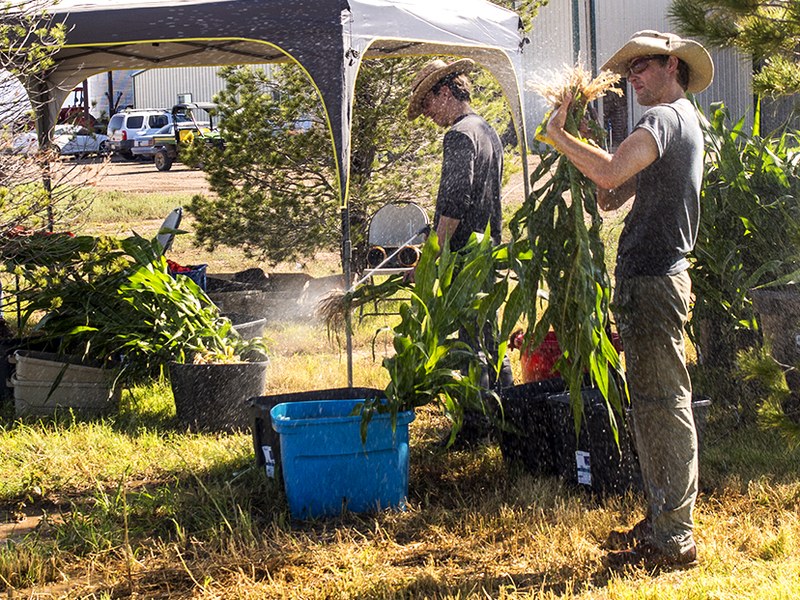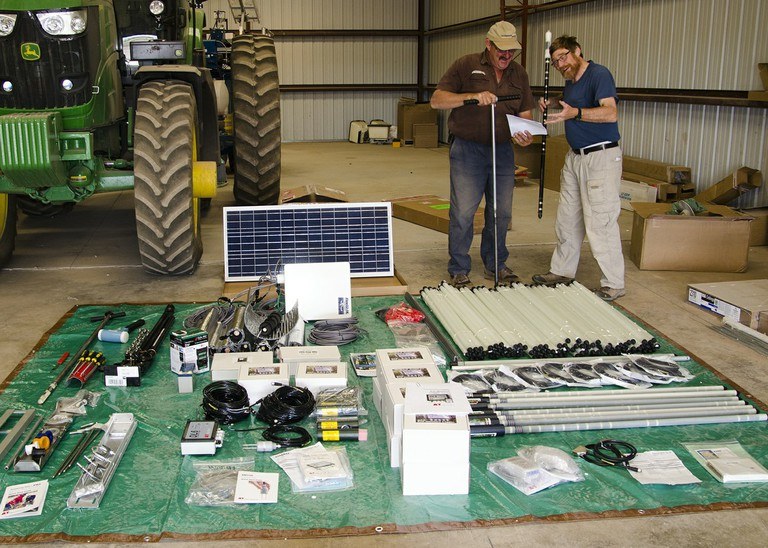The Apache Root Biology Center (ARBC) was established in 2012 by the Howard G. Buffett Foundation for the Roots lab located in Willcox, AZ, USA.

Early field season image from maize plots at ARBC in 2015.
The Roots lab began field operations at the Apache Root Biology Center in 2013, which included stress trials of thousands of maize and bean accessions. Field photos from 2013, 2014, and 2015 at ARBC are in the galleries below.
The ARBC is located in a high desert ecosystem suitable for studies of drought stress. The ARBC consists of 40 ha of land under center pivot, and drip irrigation systems for automated application of irrigation, fertilizers, and pesticides, with access to modern research plot machinery including a precision planter and plot combine.

Maize and bean trials are planted using precision plot planter.
Current research focuses on maize and bean responses to drought stress. In 2015, many maize and bean diversity panels were planted at the ARBC to examine root architectural and anatomical variation and assess various physiological responses to drought. Individual plants are dug up and washed for sample collection in a process called "shovelomics."

Shovelomics of maize requires thorough root washing for root sample collection.
A research facility was constructed that includes a lab complex building totaling 4,400 sq ft, equipped for root biology studies. The lab complex building contains a wet lab (1,350 sq ft), rooms for grinding plant material and soils and storage of supplies, a large cold room for storage of samples and seeds, and two multi-purpose rooms (1,125 sq ft and 875 sq ft). Other buildings at the site include two metal equipment sheds (3,200 sq ft and 1,800 sq ft), and a pole barn with concrete floor (4,800 sq ft).
Supporting equipment for field research includes soil coring tubes and supplies, an automated root washer, instruments for soil and plant tissue analysis and soil moisture content. Soil moisture equipment includes Dynamax PR2 Profile Probes with HH2 hand-held readout units and the SapIP wireless data transfer system with internet access to the AgriSensors software for data storage, viewing, and retrieval.

New analytical tools will enable high-throughput phenotyping of crops under drought and nitrogen treatments.
Supporting instrumentation and equipment for field-work includes Li-Cor 6400XT Photosynthesis system, Li-Cor 191SA Line quantum sensor and Li-Cor -1400 data logger, Li-Cor LAI 2200 Plant Canopy Analyzer, Decagon SC-1 leaf porometer, PMS Pressure Instrument, Konica Minolta SPAD meter for leaf chlorophyll measurement, Nikon D600 digital camera for root crown imaging and an Echo-type plant tissue drier.
The laboratory is equipped with a Perkin Elmer Lambda 25 UV-Vis spectrophotometer, Li-3100C leaf area meter, Decagon Hyprop soil moisture system, Decagon WP4C Water Potential Meter, Wescor vapor pressure osmometer, balances, centrifuges and a shaker, laboratory drying oven, dry ice generator, microscopes, flatbed scanner, and computer with WINRHIZO PRO, a water purification system, fume hood, various tissue grinding mills, a muffle furnace, pipets, glassware and consumable supplies for sample processing/analysis.

The Li-3100C leaf area meter was a new addition to the lab in 2015.
On-site lodging is available for 9 researchers/technicians. Under the existing sponsorship of the Howard G Buffett Foundation, a Penn State agronomist lives at the Center and supervises operations from April to September of each year.

Facilities include a research lab with cold room, tractor sheds, and housing within a short walk from the fields.
Photos by Stephanie Klein (1-2) and Robert Snyder (3-6).
The Roots lab began field ops at the Apache Root Biology Center in 2013.
Roots Lab, second year at ARBC.
Photos from the lab, field work, and day trips to the surrounding area.

